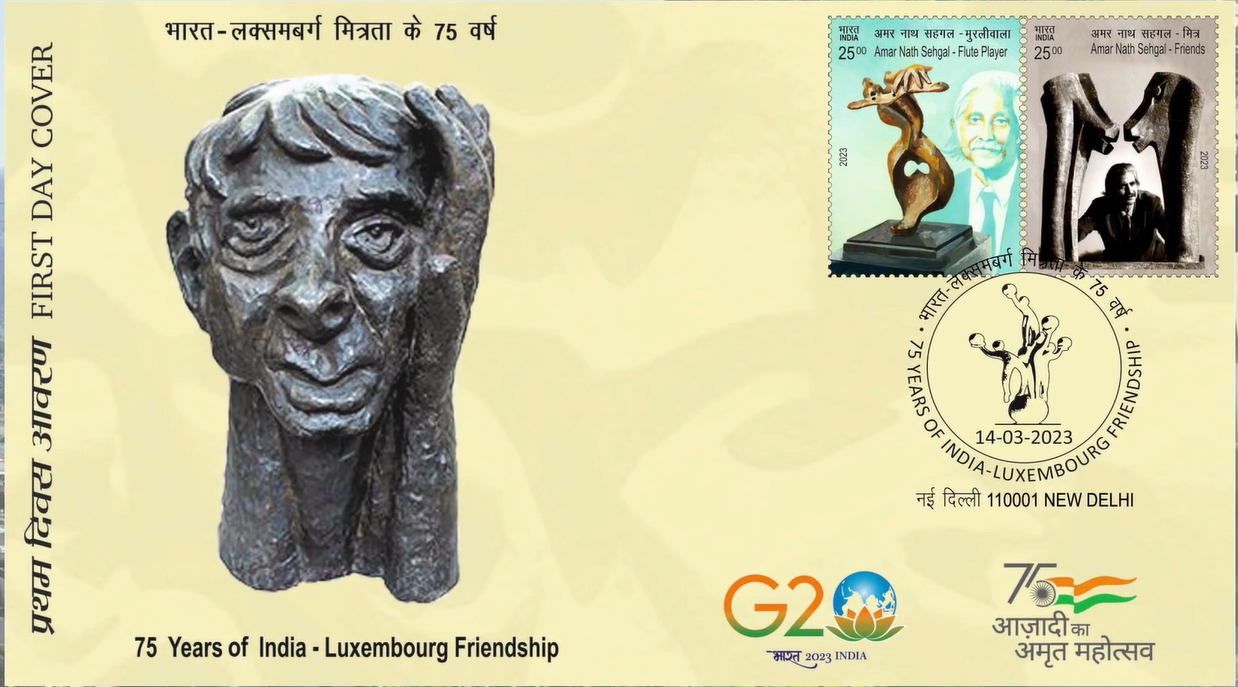75 Years of India – Luxembourg Friendship

Technical Data
| Date of Issue | March 14, 2023 |
|---|---|
| Denomination | Rs. 50 |
| Quantity | 116,000 |
| Perforation | 13½ |
| Printer | Security Printing Press, Hyderabad |
| Printing Process | Wet Offset |
| Watermark | No Watermark |
| Colors | Multicolor |
| Credit (Designed By) | Ms. Nenu Gupta Shri Anuj Zood |
| Catalog Codes |
Stanley Gibbons IN MS3847 Colnect codes IN 2023.03.14-01 Michel IN BL242 Yvert et Tellier IN BF226 |
| Themes | Diplomacy | Famous people | Flags | Joint Issues | Men | Sculptors | Sculptures |
Establishment of Diplomatic Relations
India and Luxembourg established diplomatic relations in 1948, soon after India’s independence. Over the decades, the two nations have nurtured a warm and friendly relationship, marked by shared democratic values, cultural appreciation, and strong cooperation across multilateral and international forums. In 2023, the two countries celebrate 75 years of diplomatic relations, reflecting their longstanding ties of trust, goodwill, and collaboration.
Amar Nath Sehgal – A Cultural Bridge
One of the most remarkable symbols of India–Luxembourg friendship is the renowned sculptor Amar Nath Sehgal. Born on 5 February 1922 in Campbellpur (pre-partition India), Sehgal initially studied Industrial Chemistry at Banaras Hindu University and worked briefly as an engineer in Lahore. However, his passion for art led him to pursue fine arts at New York University in 1948. On returning to India, he served as faculty at the College of Art, Delhi, and began an extraordinary artistic journey spanning over six decades.
Sehgal’s creative oeuvre extended across sculptures, paintings, poetry, graphics, and tapestries. His art combined traditional Indian spirit with global modernist sensibilities, earning him worldwide recognition. He was appointed by UNESCO in 1955 to survey India’s folk arts, awarded the Lalit Kala Akademi Fellowship in 1993, and honored posthumously with the Padma Bhushan in 2008.
Life in Luxembourg
In 1979, Sehgal established a studio in the Grand Duchy of Luxembourg. For the next 24 years, he lived between India and Luxembourg, leaving a profound imprint on both countries. His works are housed in the National Museum of History and Art, the Central Bank of Luxembourg, the City of Luxembourg, and several private collections.
Sehgal also contributed to strengthening cultural exchanges between the two nations. In 1986, he founded “The Creative Fund” in Luxembourg with Prime Minister Jacques Santer, to provide young artists from India and Luxembourg opportunities for cultural discovery and inspiration. This initiative enriched people-to-people ties and deepened mutual understanding.
Mahatma Gandhi in Luxembourg
Sehgal’s iconic bronze bust of Mahatma Gandhi, commissioned by philanthropist Henry Leir, was installed in Luxembourg City’s Municipal Park in 1978. Although the bust was stolen in 1980, Sehgal offered another casting of the original, which was reinstalled on 2 October 1982, Mahatma Gandhi’s 113th birth anniversary. Today, the statue remains a beloved landmark in Luxembourg, symbolizing Gandhi’s universal message of peace, tolerance, and non-violence.
In 2019, to mark the 150th birth anniversary of Mahatma Gandhi, India and Luxembourg jointly released a commemorative postage stamp featuring Sehgal’s Gandhi statue—an enduring symbol of Indo-Luxembourg friendship.
Iconic Sculptures
The Friends (1988)
Sehgal’s sculpture The Friends, created in 1988, is a poignant representation of equality, respect, and friendship. The two bronze figures facing each other embody mutual strength and trust, resonating with the deep bonds between India and Luxembourg. This sculpture not only reflects Sehgal’s personal journey of finding a second home in Luxembourg but also celebrates the harmony of two nations with shared values. In 2019, the piece was loaned to the Embassy of Luxembourg in New Delhi, further enriching cultural ties.
Flute Player (1958)
Another masterpiece, Flute Player, represents Lord Krishna, a deity revered across the Indian subcontinent. Through this bronze sculpture, Sehgal captured Krishna’s eternal charm—wise yet playful, tender yet strong, and deeply spiritual. The flute, often seen as a symbol of the human heart, is brought to life by Krishna’s divine music, symbolizing love and blessings. Created in 1958, this work exists in several editions across private and public collections, including the Museum of Modern Art, Paris and the National Museum of History and Art, Luxembourg. It was also presented to UNICEF on behalf of the children of India.
Joint Philatelic Issue
To mark the 75th anniversary of diplomatic relations, the Department of Posts, Government of India, and Luxembourg Post are jointly issuing a Souvenir Sheet featuring Sehgal’s masterpieces. This release celebrates his centenary and artistic genius while reaffirming the strong cultural bonds and shared values between India and Luxembourg.
First Day Cover

